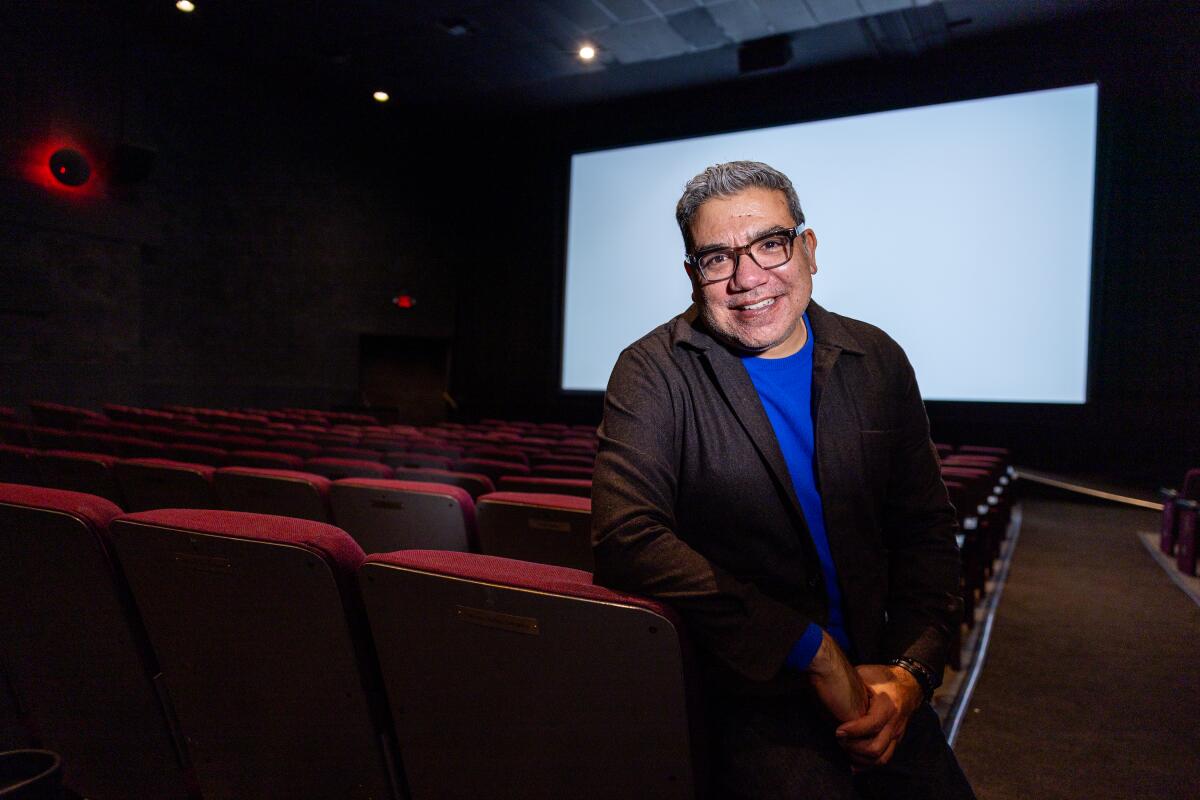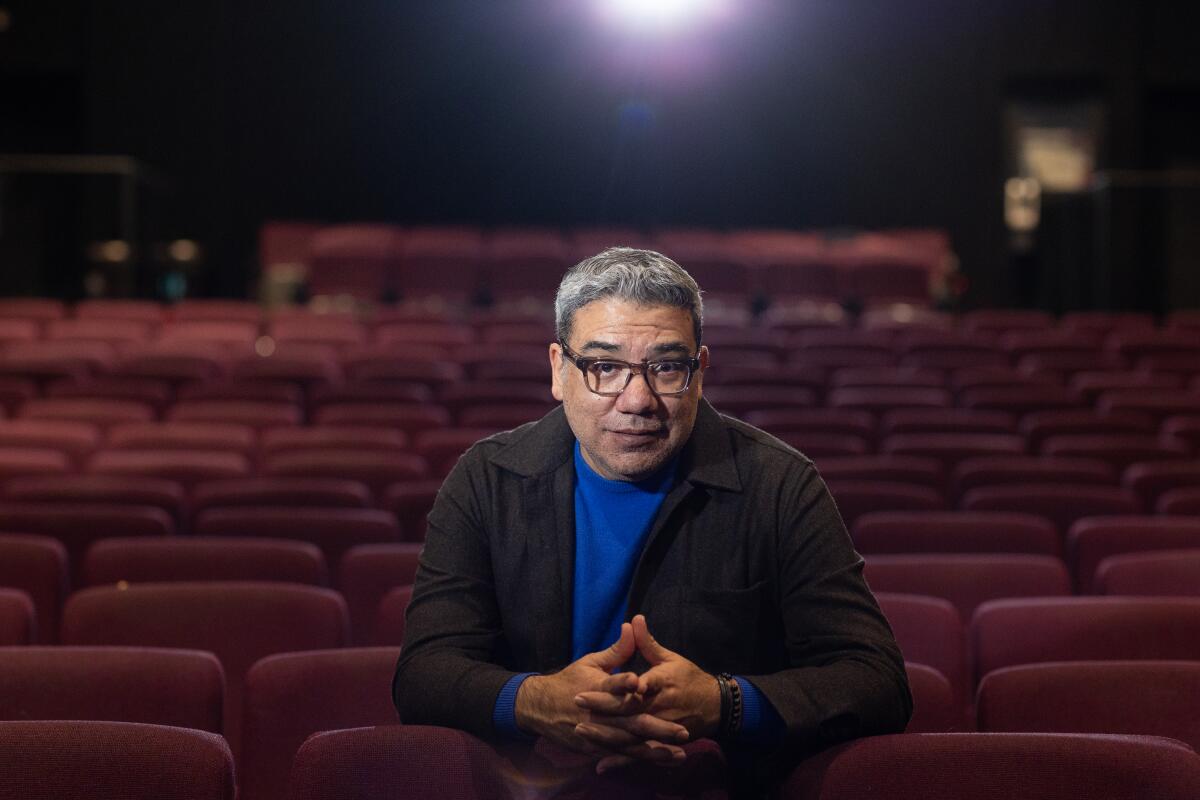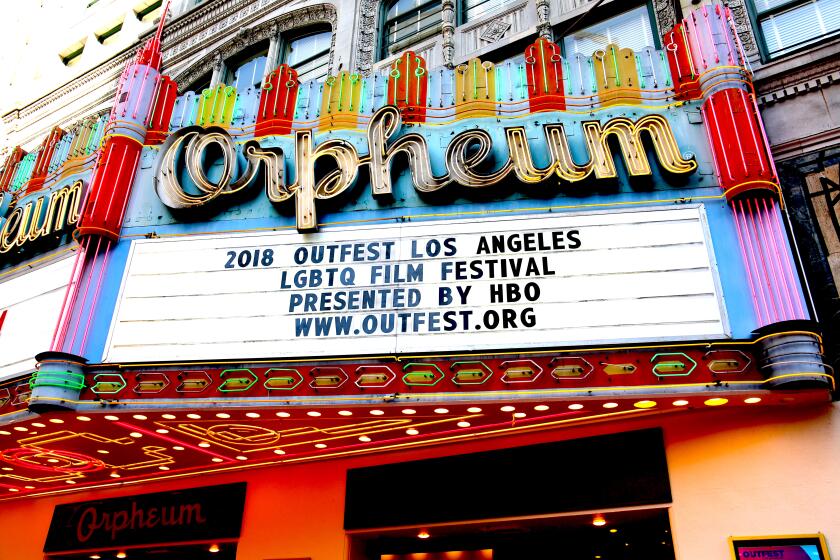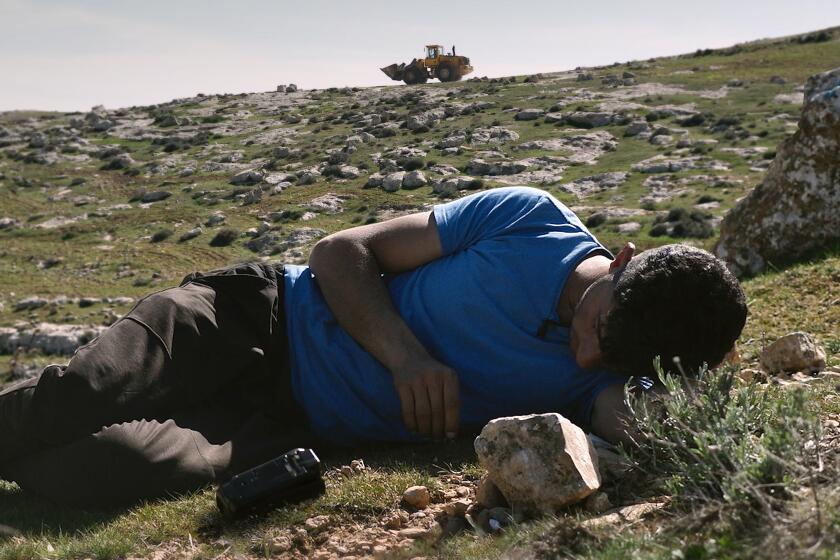Sundance’s new director Eugene Hernandez keeps festival’s legacy in mind — and its future

- Share via
The Sundance Film Festival will launch its 40th edition later this month, welcoming back such alumni as Steven Soderbergh, Dee Rees, Richard Linklater and Kristen Stewart as part of the event. It will be the first full edition for new festival director Eugene Hernandez, charged with stewarding the nation’s leading independent film showcase into an uncertain future for the industry at large.
Hernandez, 55, is only the fifth person to hold the job in the festival’s storied history. When the Sundance Institute, founded by Robert Redford, took over control of the U.S. Film Festival in 1985, the program included Wim Wenders’ “Paris, Texas,” Jim Jarmusch’s “Stranger Than Paradise” and the Coen brothers’ “Blood Simple.”
In subsequent years the festival has helped launch a wide array of major filmmakers, including Christopher Nolan, Quentin Tarantino, Ava DuVernay, Ryan Coogler, Chloé Zhao, Damien Chazelle, Paul Thomas Anderson and countless others.
With film production still reeling from the aftermath of last year’s strikes, exhibition is continuing to find its footing from the one-two punch of the pandemic and the rise of streaming. Many audiences that used to visit art houses for the kind of specialized titles that reliably emerged from Sundance have not returned in full force to theaters, having grown accustomed to watching small-scale, intimate indies at home.
All of which is to say that someone coming into a position specifically tasked with reengaging the industry and audiences alike may feel a certain pressure to perform in their first year on the job.
“The pressure that I feel is my enduring respect for the legacy of the institution and the festival,” said Hernandez, “the desire to be respectful of everything that Sundance has created, everything that Mr. Redford has done at the institute for 40-plus years.
“I do feel a strong sense of responsibility to remain focused and centered on what I’ve always seen the institute do in the many moments of uncertainty or change that it has withstood,” Hernandez added. “And that is always returning to the focus on the artist and returning to centering the artist and the art form.”
Last year was an especially good lineup for the festival, one that included the premieres of such future critics’ darlings as “Past Lives,” “Passages,” “Fair Play,” “A Thousand and One,” “Kokomo City,” “All Dirt Roads Taste of Salt” and “Still: A Michael J. Fox Movie.” Additionally, the Australian horror film “Talk to Me,” which played in the Midnight section of the festival, went on make nearly $50 million at the U.S. box office.
Heading into this year, the festival saw a record number of submissions.
“Despite all the uncertainty around the fate of independent films and series, we have this beautiful rush of submissions — more than 17,000 this year,” Hernandez said. “And so I think the mission is really to try to continue to do what Sundance has always done, and that is watch all of them and make a selection that can represent where the future of independent storytelling is heading.”

Hernandez, who identifies as Latinx and queer, comes to Sundance after 11 years at Film at Lincoln Center, where he rose to the positions of senior vice president of FLC, publisher of Film Comment and executive director of the prestigious New York Film Festival, where he kept the flames burning during three tricky years of the pandemic.
Raised in Indio, Calif., Hernandez attended UCLA before eventually moving to New York City in 1994. He co-founded and was longtime editor-in-chief of the website IndieWire, a publication that has grown into a vital resource for news on the world of independent film.
Hernandez’s hiring at Sundance was announced in September 2022, replacing Tabitha Jackson after only two years on the job. After wrapping that year’s New York Film Festival in October and taking a few weeks off, Hernandez joined Sundance in November to observe the planning and inner workings of the festival’s 2023 edition. He fully dove into an active role as soon as last year’s festival had wrapped. Hernandez noted that since taking the Sundance job, he has bounced between spending time at the organization’s offices in Utah, New York and Los Angeles.
The position of festival director sits right at the intersection between the needs of the industry — including distributors, producers and financiers — and those of the creative artists themselves. Reconciling the needs and wants of those two sides can be a big part of the job.
John Cooper, who was director of the festival from 2009 to 2020, knows it can be a challenge to satisfy all the assorted stakeholders.
“There’s the industry giving you input and then there are the artists giving you input and you’re really building it for a way of connecting those two,” said Cooper over Zoom. “But you’re not really leading as much as listening —especially listening to the filmmakers. What do you really need now as you make a film? What is it you need for the 10 days of Sundance? What is it you need for the world? And you have to kind of stick with how can those 10 days give you as much as possible.”
Hernandez remembers his first time at Sundance in 1993. He was at the first screening of Robert Rodriguez’s low-budget debut feature, “El Mariachi” — Hernandez still has his ticket — and recalled what it meant to be in that exact room at that exact time.
“To be at a place where literally no one had seen this movie yet,” said Hernandez, “you’re the first audience watching it, and the director is there and is kind of roughly your age and onstage and talking about making that movie and all the struggles they went through to get it on the screen. That was a huge lightbulb moment for me.”
It was also during his first trip to Sundance, while riding a shuttle bus, that Hernandez met budding journalist Mark Rabinowitz. They, along with Cheri Barner, would go on to co-found the website that would become IndieWire. (Hernandez sold his stake in the site and left the organization long before its 2016 sale to Penske Media Corp.)
That kind of seeming happenstance, that you can meet someone on a festival shuttle and change the direction of your life, is a part of the Sundance myth that Hernandez hopes to hold onto. It’s still possible for anyone coming to participate in the event.
“If you’re a kid in your 20s now, or even younger, and you’re inspired to find out more about what a festival is or what Sundance is, I feel like part of my job is to create the space for that discovery to happen,” said Hernandez. His goal is “to create the space for those chance encounters to happen, whether they’re on the mountain in Utah or whether it’s watching something on our platform during the second week of the festival and seeing something that maybe you’ve never seen before.
“We are part of an ecosystem,” he added. “We are not separate from it. We are part of it.”
Hernandez’s unique background in journalism, publishing and the festival world makes him ideally suited to his multifaceted new role at Sundance as the festival faces the future.
“He’s very insightful and just someone who really understands and thinks a lot about where the industry is,” sad Joana Vicente, CEO of Sundance Institute, herself recently appointed in 2021. “He’s someone who really knows how to listen, is always wanting to hear what people think, always asking questions. And I think that that has served him really well.”
Sundance’s complex function as an incubator and launching pad for new talent is front of mind for Hernandez, according to Vicente. “He’s very committed to thinking about the festival as not something that serves just one purpose but thinking about the deeper purpose and how do we evolve to continue to be as relevant as ever,” she said . “And I think that’s the big question that drives him. And so it’s not about, ‘Oh, now we have a new section of the festival,’ or ‘We’re no longer doing this and doing that instead.’ It’s how can we be as relevant each year as we possibly can be and how can we deliver for these filmmakers the absolute best platform so that they go on and have incredible careers?”
With Sundance celebrating a milestone anniversary while welcoming its new festival director, this year will be a combination of looking back and looking ahead.
“You really always get this snapshot of what the state of our storytelling is, and, to say it even more broadly, the state of our culture,” said Hernandez.
Much of this year’s on-the-ground conversation may revolve around the hot-button topic of artificial intelligence: Numerous films, including Gary Hustwit’s “Eno,” a documentary portrait of artist-musician Brian Eno that uses generative AI (it’s different every time it is screened), and the tech-themed fiction film “Love Me” from Sam and Andy Zuchero, touch on the subject. There are also a number of festival-hosted panels that will focus on the use of AI and technology in creative storytelling.
“What Sundance has always done so well is start the conversation and add complexity,” said Hernandez. “So if where we end up at the end of that is ‘Was this the year of AI?’ then I hope that we’ve had the opportunity to dig in even more deeply, to continue grappling with what that means right now and where it might be taking us, and what we might need to do to navigate it.
“But it really is when the films meet the audience that the festival takes life,” he added. “And those are the conversations that I just can’t wait to have.”
More to Read
Only good movies
Get the Indie Focus newsletter, Mark Olsen's weekly guide to the world of cinema.
You may occasionally receive promotional content from the Los Angeles Times.











